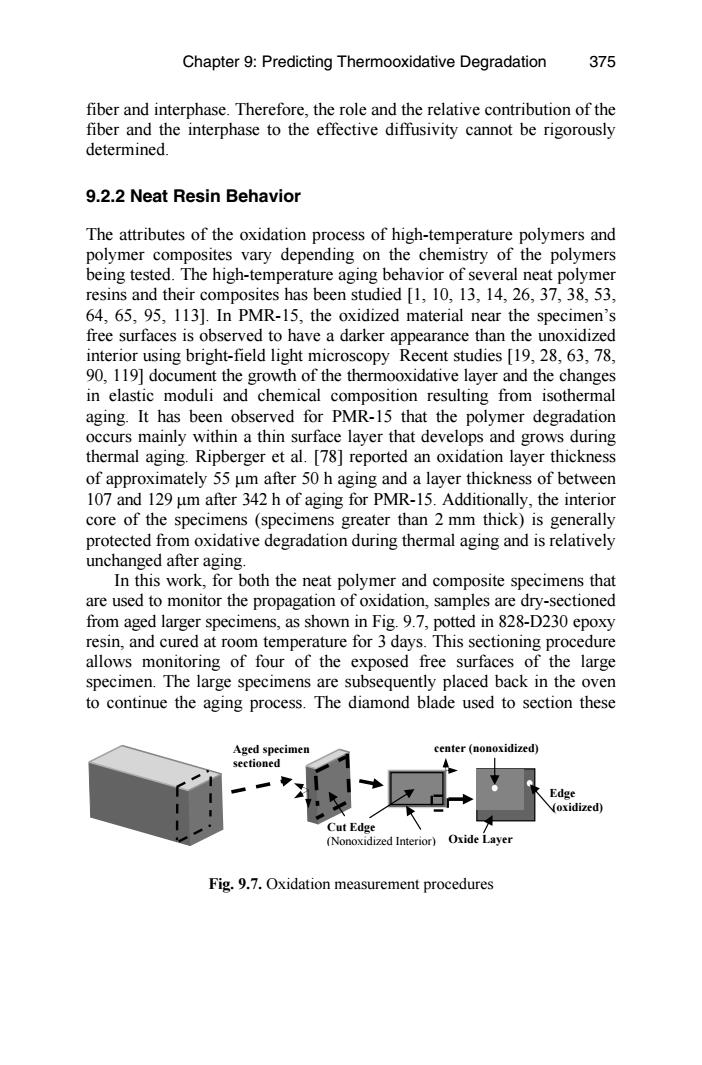正在加载图片...

Chapter 9:Predicting Thermooxidative Degradation 375 fiber and interphase.Therefore,the role and the relative contribution of the fiber and the interphase to the effective diffusivity cannot be rigorously determined. 9.2.2 Neat Resin Behavior The attributes of the oxidation process of high-temperature polymers and polymer composites vary depending on the chemistry of the polymers being tested.The high-temperature aging behavior of several neat polymer resins and their composites has been studied [1,10,13,14,26,37,38,53. 64,65,95,113].In PMR-15,the oxidized material near the specimen's free surfaces is observed to have a darker appearance than the unoxidized interior using bright-field light microscopy Recent studies [19,28,63,78, 90,119]document the growth of the thermooxidative layer and the changes in elastic moduli and chemical composition resulting from isothermal aging.It has been observed for PMR-15 that the polymer degradation occurs mainly within a thin surface layer that develops and grows during thermal aging.Ripberger et al.[78]reported an oxidation layer thickness of approximately 55 um after 50 h aging and a layer thickness of between 107 and 129 um after 342 h of aging for PMR-15.Additionally,the interior core of the specimens (specimens greater than 2 mm thick)is generally protected from oxidative degradation during thermal aging and is relatively unchanged after aging. In this work,for both the neat polymer and composite specimens that are used to monitor the propagation of oxidation,samples are dry-sectioned from aged larger specimens,as shown in Fig.9.7,potted in 828-D230 epoxy resin,and cured at room temperature for 3 days.This sectioning procedure allows monitoring of four of the exposed free surfaces of the large specimen.The large specimens are subsequently placed back in the oven to continue the aging process.The diamond blade used to section these Aged specimen center (nonoxidized) sectioned Edge (oxidized) Cut Edge (Nonoxidized Interior)Oxide Layer Fig.9.7.Oxidation measurement procedures9.2.2 Neat Resin Behavior The attributes of the oxidation process of high-temperature polymers and polymer composites vary depending on the chemistry of the polymers being tested. The high-temperature aging behavior of several neat polymer resins and their composites has been studied [1, 10, 13, 14, 26, 37, 38, 53, 64, 65, 95, 113]. In PMR-15, the oxidized material near the specimen’s free surfaces is observed to have a darker appearance than the unoxidized interior using bright-field light microscopy Recent studies [19, 28, 63, 78, 90, 119] document the growth of the thermooxidative layer and the changes in elastic moduli and chemical composition resulting from isothermal aging. It has been observed for PMR-15 that the polymer degradation occurs mainly within a thin surface layer that develops and grows during thermal aging. Ripberger et al. [78] reported an oxidation layer thickness of approximately 55 µm after 50 h aging and a layer thickness of between 107 and 129 µm after 342 h of aging for PMR-15. Additionally, the interior core of the specimens (specimens greater than 2 mm thick) is generally protected from oxidative degradation during thermal aging and is relatively unchanged after aging. In this work, for both the neat polymer and composite specimens that are used to monitor the propagation of oxidation, samples are dry-sectioned from aged larger specimens, as shown in Fig. 9.7, potted in 828-D230 epoxy resin, and cured at room temperature for 3 days. This sectioning procedure allows monitoring of four of the exposed free surfaces of the large specimen. The large specimens are subsequently placed back in the oven to continue the aging process. The diamond blade used to section these Fig. 9.7. Oxidation measurement procedures Oxide Layer Edge (oxidized) Cut Edge (Nonoxidized Interior) Aged specimen center (nonoxidized) sectioned fiber and interphase. Therefore, the role and the relative contribution of the fiber and the interphase to the effective diffusivity cannot be rigorously determined. Chapter 9: Predicting Thermooxidative Degradation 375